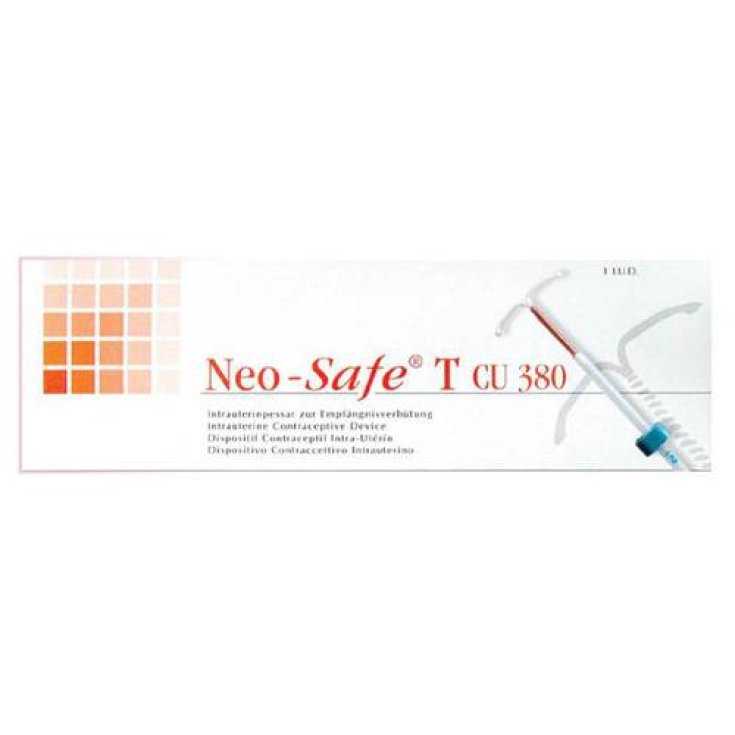Neo-Safe T Cu 380 Mini Intrauterine Contraceptive Device
53.29€
55.00€

- Brand: MKT PHARMA Sas di Rita Guido
- Product Code: 970659126
- EAN: 9088884211003
- Availability: In Stock
- Purchase 3 items for 52.22€ each
- Purchase 4 items for 51.16€ each
- Purchase 5 items for 50.09€ each
Neo-Safe
T Cu 380 Mini
Intrauterine Contraceptive Device
Composition
The Neo-Safe T CU 380 Mini (DIU) intrauterine device is composed of a T- shaped polyethylene and baric sulphate structure. The longitudinal arm is wrapped in a copper wire. The surface of the copper has a section of 380 mm 2 . Two threads are attached to the lower part of the rod.
Dimensions:
Neo-Safe T eu 380 Mini is 24.0mm ± 0.2mm wide and 30.0mm ± 0.2mm long.
The polyethylene arms and the copper spiral are opaque to X-rays.
Operation and potential effectiveness
There are several types of intrauterine pessaries as an anti-contraceptive method. Extensive international studies show that copper pessaries are more effective and safer in the long term. Furthermore, it has been recognized that the Neo-Safe T CU 380 Mini intrauterine pessaries are the most effective method of contraception that has been developed. The Neo-Safe T CU 380 Mini has been designed to prevent any irritation to the uterus. Normally it is inserted during the cycle. Insertion generally does not cause pain. First, the opening of the uterus and the length of the cervix are checked. Then the DIU is gently inserted into the neck until it sits in the correct position at the bottom. The Neo-Safe CU 380 Mini protects against pregnancy the moment it is inserted.
The Neo-Safe T CU 380 Mini is effective for a duration of 5 years.
The effectiveness of intrauterine pessaries can only be compared to contraceptive pills. No contraceptive method guarantees one hundred percent safety. However, with the Neo-Safe T CU 380 Mini you are practically safe. The functioning of the intrauterine device is not yet fully known. In the current state of knowledge, it is assumed that the protection mechanism is guaranteed by a defect in the normal functioning of the male gametes (spermatozoa), which are no longer able to fertilize the female egg. Furthermore, it is assumed that the branch ions affect the development of the egg in such a way as to prevent fertilization: the intrauterine device is therefore no longer considered an abortive method.
Contraindications
Neo-Safe T CU 380 Mini must not be used in case of:
1. Serious diseases of the genital system
2. Vaginal bleeding
3. Pregnancy
4. Premature uterine pregnancy or factors predisposing its possibility
5. Infections of the genital tract
6. Sexually transmitted diseases, during the last 12 months (excluding bacterial vaginitis, repeated herpes and hepatitis B)
7. Termination of pregnancy with infection during the last three months, inflammatory diseases in the pelvic area
8. Deformations of the uterus (innate or acquired)
9. Allergies to copper.
The application is not recommended in case of:
1. Diseases of the heart valves
2. Anemias
3. Blood clotting problems
4. Treatments with anti-inflammatory drugs
5. Wilson disease
6. Frequent change of partners
7. Women who have not yet given birth.
Possible complications and precautions
Normally the first three cycles after insertion are different from the patient's normal cycle. Blood flow is more abundant and spasms may occur, and bleeding may occur both before and after your period. After the third or fourth cycle following insertion of the device, menstruation usually returns to normal. Sometimes this change occurs between cycles.
You should contact your doctor if:
- does not hear the wires of the DIU;
- You or your partner are unable to hear the lower end of the UDI;
- think you are pregnant;
- experience abdominal pain, fever or unusual vaginal discharge;
- You or your partner experience pain or discomfort during intercourse;
- your menstruation is delayed, as pregnancy may rarely occur outside the uterine cavity, for example in a fallopian tube (ectopic pregnancy);
- want to have the DIU removed and / or want to get pregnant.
Insertion and removal
Prior to insertion, the patient must be adequately informed about the effectiveness, risks and contraindications of the IHL. A complete gynecological examination is recommended, including the abdominal region and a cervical smear. Must not be present: pregnancy, abdominal infections and sexually transmitted diseases. It is necessary to check the position of the uterus and the length of the cervix.
The instructions for inserting the device must be followed carefully and the patient's file must be filled in together with the attending physician. We recommend a follow-up visit 4-12 weeks after insertion and, unless otherwise indicated, an annual visit. The device is usually inserted during or immediately after menstruation. If pregnancy can be ruled out, the Neo-Safe T CU 380 Mini can be inserted during your period. It can also be inserted after a termination of pregnancy in the first three months. After giving birth, it is recommended to wait at least six weeks before inserting it, otherwise you risk increasing the possibility of perforation or rejection. There are no particular contraindications for the device in case of breastfeeding.
The DIU is removed by gently pulling the threads. If the threads are not seen and the device is in the cervix, removal should be postponed until the next period, as the threads are usually visible immediately after menstruation. If they are not seen if the threads are not visible after menstruation, the device can be removed with the use of a narrow tenaculum. This may make it necessary to enlarge the uterine canal. After the removal of the device, the patient becomes fertile again.
If a woman wishes to continue using one device as a method of contraception, she may insert another in that circumstance. If pregnancy is not desired, the removal of the device should take place during menstruation. If the device is removed in the middle of her period and the woman has had intercourse a week earlier, the risk of pregnancy still exists even if a new device has been inserted immediately after removal.
Minor pain and blood loss may occur during insertion and removal. In the presence of circulation disturbances, this application can cause fainting and, in the case of epileptic patients, a seizure. It is recommended to see a doctor for a check-up one month after the Neo-Safe T CU 380 Mini has been inserted, in order to ensure that the DIU is still in the uterus and is correctly positioned. Then an annual visit is recommended. He should also check that the DIU is still in the uterus by reaching the apex of the vagina, in a squatting position, with clean fingers in order to feel the threads. You don't pull wires.
If you cannot feel the wires or can feel more of the Neo-Safe TCU 380 Mini and not just the wires, consult your doctor immediately. This means that the UID is not in the womb or that it is not positioned correctly, which increases the chances of getting pregnant. It is recommended that you use an additional method of contraception until you have consulted your doctor. It is good practice to check once a month that the Neo-Safe T CU 380Mini is correctly positioned.
Compatibility
The experiences acquired so far in the application of the Neo-Safe T CU 380 Mini show that, in general, any alterations in the contraceptive effect of the NeoSafe T CU 380 Mini in the presence of drug administration can be excluded. However, the publications on this product indicate a reduction in efficacy in case of prolonged administration of non-spheroidal, anti-inflammatory drugs (in particular acetylsalicylic acid) and corticoids. For short administrations of non-spheroidal anti-inflammatory drugs for the treatment of forms of dysmenorrhea, no alteration of the contraceptive effect was found.
Contraindications
In individual cases, pain or dizziness may occur after inserting the device. If these disturbances persist even after one hour of rest, it means that the device has not been inserted correctly. At that point it is advisable to check the position and, if necessary, remove it. The device can also cause allergic skin reactions. The device is sterilized.
Patient record
Please complete it carefully with your doctor and keep it in a safe place.
These sterile pessaries are for single use only and cannot be reused

